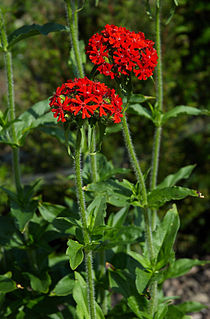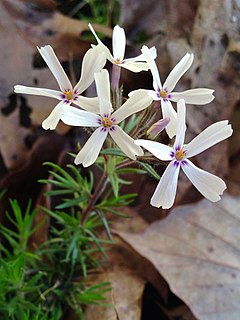
Chives, scientific name Allium schoenoprasum, is a species of flowering plant in the family Amaryllidaceae that produces edible leaves and flowers. Their close relatives include the common onions, garlic, shallot, leek, scallion, and Chinese onion.

Silene chalcedonica, the Maltese-cross or scarlet lychnis, is a species of flowering plant in the family Caryophyllaceae, native to central and eastern Russia, Kazakhstan, Mongolia and northwestern China. Other common names include flower of Bristol, Jerusalem cross and nonesuch.

Allium vineale is a perennial, bulb-forming species of wild onion, native to Europe, northwestern Africa and the Middle East. The species was introduced in Australia and North America, where it has become a noxious weed.

Phoenix roebelenii, with common names of dwarf date palm, pygmy date palm, miniature date palm or robellini palm, is a species of date palm native to southeastern Asia, from southwestern China, northern Laos and northern Vietnam,.

Wisteria sinensis, commonly known as the Chinese wisteria, is a species of flowering plant in the pea family, native to China, in the provinces of Guangxi, Guizhou, Hebei, Henan, Hubei, Shaanxi, and Yunnan. Growing 20–30 m (66–98 ft) tall, it is a deciduous vine. It is widely cultivated in temperate regions for its twisting stems and masses of scented flowers in hanging racemes, in spring.

Rhus typhina, the staghorn sumac, is a species of flowering plant in the family Anacardiaceae, native to eastern North America. It is primarily found in southeastern Canada, the northeastern and midwestern United States, and the Appalachian Mountains, but it is widely cultivated as an ornamental throughout the temperate world.

Lavandula angustifolia, formerly L. officinalis, is a flowering plant in the family Lamiaceae, native to the Mediterranean. Its common names include lavender, true lavender or English lavender ; also garden lavender, common lavender, and narrow-leaved lavender.

Ribes sanguineum, the flowering currant, redflower currant, red-flowering currant, or red currant is a North American species of flowering plant in the family Grossulariaceae, native to the western United States and Canada.

Jasminum nudiflorum, the winter jasmine, is a slender, deciduous shrub native to China. The flower's blossoming peaks right after winter, which is why it is also named Yingchun (迎春) in Chinese, which means "the flower that welcomes Spring". It is widely cultivated as an ornamental and is reportedly naturalized in France and in scattered locations in the United States.

Trachelospermum jasminoides is a species of flowering plant in the family Apocynaceae, native to eastern and southeastern Asia. Common names include confederate jasmine, southern jasmine, star jasmine, confederate jessamine, and Chinese star jasmine.

Allium caeruleum is an ornamental bulbous plant of the onion genus, native to Central Asia. In these regions, it is found on dry slopes, plains, and steppes.

Phlox subulata the creeping phlox, moss phlox, moss pink or mountain phlox, is a species of flowering plant in the family Polemoniaceae, native to eastern and central USA, and widely cultivated. Growing to about 13 cm (5 in) high at most and covering a 50 cm (20 in) wide area, it is an evergreen perennial forming mats or cushions of hairy, linear leaves. The small, five-petaled flowers bloom in rose, mauve, blue, white, or pink in late spring to early summer.

Allium unifolium, the one-leaf onion or American garlic, is a North American species of wild onion. It is native to the coastal mountain ranges of California, Oregon, and Baja California. It grows on clay soils including serpentine, at elevations up to 1100 m.

Gypsophila repens, the alpine gypsophila or creeping baby's breath, is a species of flowering plant in the family Caryophyllaceae, native to the mountains of central and southern Europe, where it grows on dry, chalky slopes. The Latin name literally means "creeping chalk-lover". It is a prostrate, mat-forming herbaceous perennial, growing around 20 cm (8 in) tall by 30–50 cm (12–20 in) wide. For much of the summer it bears masses of star-shaped flowers which may be white, lilac or light purple, in loose panicles.

Ipheion uniflorum is a species of flowering plant, related to the onions, so is placed in the allium subfamily (Allioideae) of the Amaryllidaceae. It is known by the common name springstar, or spring starflower. Along with all the species of the genus Ipheion, some sources place it in the genus Tristagma, but research published in 2010 suggested that this is not correct. It is native to Argentina and Uruguay, but is widely cultivated as an ornamental and reportedly naturalized in Great Britain, France, Australia, New Zealand and the United States.

Sambucus racemosa is a species of elderberry known by the common names red elderberry and red-berried elder.

Linaria maroccana is a species of flowering plant in the plantain family known by the common names Moroccan toadflax and annual toadflax. It is native to Morocco, but it can be found elsewhere growing wild as an introduced species, such as California. It is a readily available ornamental plant for the flower garden. This is an annual herb growing erect to approach a maximum height of 50 cm (20 in), its stem with linear leaves 2–4 cm (0.8–1.6 in) long. The inflorescence is a raceme of flowers occupying the top of the stem. At the base of each flower is a calyx with five narrow, pointed lobes. The flower is 2–4 cm (0.8–1.6 in) long with five lobes arranged into two lips with a spur at the end. The flower is often purple in color with white near the throat, but flowers of many different colors are bred for the garden. Dwarf cultivars are also available.

Allium senescens, commonly called aging chive, German garlic, or broadleaf chives, is a species of flowering plant in the genus Allium.

Iris aucheri, the Aucher-Éloy iris, is a species of flowering plant in the family Iridaceae. It is a bulbous perennial in the Juno group of irises.
Allium jesdianum is a species of onion found mainly in Iran, with populations in Afghanistan and possibly Iraq and Uzbekistan. It is cultivated around the world as an ornamental. Its 'Akbulak' and 'Early Emperor' cultivars gained the Royal Horticultural Society's Award of Garden Merit in 2016, and are also considered by them as good plants to attract pollinators. It has been incorrectly listed for sale by commercial nurseries as Allium rosenbachianum.






















